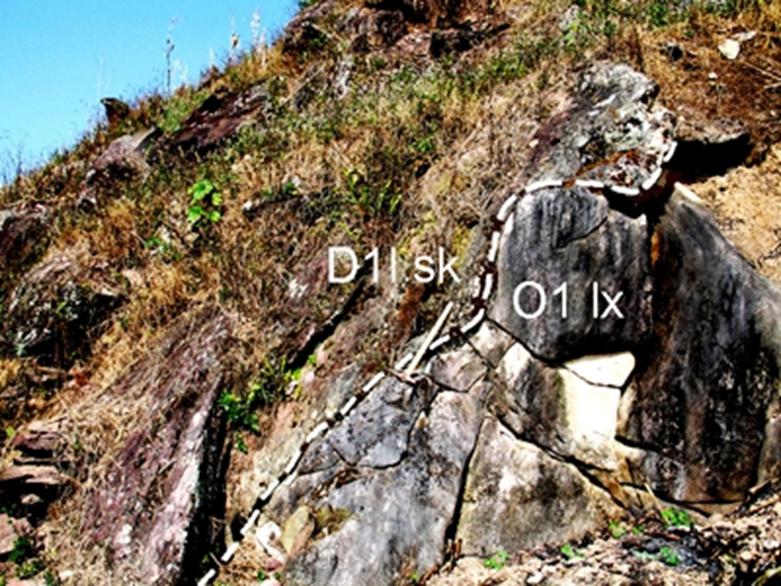Lutxia Fm
Type Locality and Naming
Upper formation in Ham Rong Gr version of East Bac Bo. Along the track from the Chang Pung border post to Dong Van Townlet, from Seo Then Pá Village to Bac Bun Village (N = 23°16’; E = 105°24’)- Deprat J. 1915. During Geological Mapping at 1:200,000 of the Bao Lac Map sheet, Hoang Xuan Tinh (1976) established the Seo Then Pa “Suite” that is a synonym of the Lutxia Fm. During Geological Mapping at 1:200,000 of the Bac Kan Map sheet, Nguyen Kinh Quoc et al. (1974) established the Ban Loa Fm in the upper course of the Song Gam River. Lithologically, this “new” unit is very similar to the Lutxia Fm and should be its synonym
Synonym: Séríe de Loutẹia: Deprat J. 1915 (Ordovicien inferiéur); Hệ tầng Lutxia: Phạm Kim Ngân, Lương Hồng Hược 1995 (O11); Tống Duy Thanh in vo Khúc el al. 2000; Điệp Lutxia: Phạm Kim Ngân 1986 (O1); VQ Khúc, Bùi Phú Mỹ et al. 1990 (O1); Hệ Ordovic, thống họ: Dovjikov A.E. et al. 1965, Phạm Kim Ngân, 1970,1975,1976, 1980; Phạm Kim Ngân, Lương Hồng Hược 1977; Hệ tầng Bản Lầu: Nguyễn Kinh Quốc et al. 1974 (O1); Điệp Seo Thèn Pá: Hoàng Xuân Tình et al. 1976 (O1)
Lithology and Thickness
Limestone and minor Claystone: Grey-banded limestone, yellow laminated claystone, chocolate and yellow laminated marl, yellowish-brown limestone, marly shale and sandy shale. In its distribution areas, according to Deprat J. (1915), this stratotype is represented by the following sequence: 1) yellow laminated claystone, 45 m thick; 2) grey banded limestone, 50 m thick; 3) chocolate and yellow laminated marl, 45 m thick; 4) yellowish-brown limestone, 20 m thick; 5) marly shale and sandy shale, 25 m thick; 6) greenish-grey limestone, 35 m thick; 7) laminated marl, 60 m; 8) lenses of brecciated limestone; 9) grey oolitic limestone, 20 m; 10) pinkish laminated marl, 4 m thick; 11) pinkish coarse sandstone, 6 m thick; 12) grey regular-bedded limestone, 90 m thick. The total thickness of this section reaches 400 m; and is 200 m in some other areas.
[Figure: Lutxia Fm: Outcrop of Lower Ordovician limestone and shale of the Lut Xia Fm in Xi Mần Kha village, Đồng Văn Distr. (images courtesy of Prof. Ta Hoa Phuong, Vietnam Natl. Univ. Hanoi)]
[Figure: Lutxia Fm: Outcrop of Lower Ordovician clayey limestone and shale of the Lut Xia Fm in Xi Mần Kha village, Đồng Văn Distr. (images courtesy of Prof. Ta Hoa Phuong, Vietnam Natl. Univ. Hanoi)]
Relationships and Distribution
Lower contact
The Lutxia Fm rests conformably upon the Chang Pung Fm
Upper contact
It is covered unconformably by the basal conglomerate bed of the Si Ka Fm (early Devonian; Dl sk). In NW corner of Ha Giang Province, the next younger unit (also early Devonian) is the unique Khao Loc Fm of carbonate.
Regional extent
According to the described sections, the beds of the Lutxia Fm in the Dong Van and Vi Xuyen area are almost metamorphosed or very weakly metamorphosed; as in the Ban Loa area (Linh Ho, Tuyen Quang Province), they are phyllitic and dolomitic. Particularly in the Ban Loa area, upper course of the Song Gam River (Tuyen Quang Province), the Lutxia Fm is exposed as a tectonic wedge between Devonian sediments.
GeoJSON
Fossils
Isotelus stenocephalus, Hysierolenus sp., Pseudokainella sp. Leiobienvillia sp., Bienvillia sp.,
Age
Depositional setting
The lithological composition of the Lutxia Fm consists mainly of carbonate interbedded with some shallow-marine facies terrigenous sediments, that belong to the Lower Paleozoic stable depositional series (Ha Giang - Chang Pung - Lutxia formations) in North Bac Bo.
Additional Information
